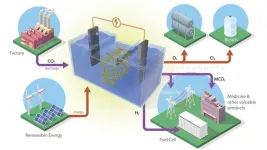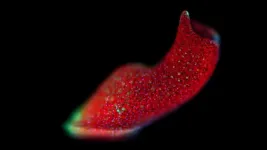(Press-News.org) https://doi.org/10.1016/j.apsb.2024.02.006
This new article publication from Acta Pharmaceutica Sinica B, discusses how branched glycopolymer prodrug-derived nanoassembly combined with a STING agonist activates an immuno-supportive status to boost anti-PD-L1 antibody therapy.
Despite the great potential of anti-PD-L1 antibodies for immunotherapy, their low response rate due to an immunosuppressive tumor microenvironment has hampered their application.
To address this issue, the authors of this article constructed a cell membrane-coated nanosystem (mB4S) to reverse an immunosuppressive microenvironment to an immuno-supportive one for strengthening the anti-tumor effect. In this system, Epirubicin (EPI) as an immunogenic cell death (ICD) inducer was coupled to a branched glycopolymer via hydrazone bonds and diABZI as a stimulator of interferon genes (STING) agonist was encapsulated into mB4S. After internalization of mB4S, EPI was acidic-responsively released to induce ICD, which was characterized by an increased level of calreticulin (CRT) exposure and enhanced ATP secretion. Meanwhile, diABZI effectively activated the STING pathway.
Treatment with mB4S in combination with an anti-PD-L1 antibody elicited potent immune responses by increasing the ratio of matured dendritic cells (DCs) and CD8+ T cells, promoting cytokines secretion, up-regulating M1-like tumor-associated macrophages (TAMs) and down-regulating immunosuppressive myeloid-derived suppressor cells (MDSCs).
Therefore, this nanosystem for co-delivery of an ICD inducer and a STING agonist achieved promotion of DCs maturation and CD8+ T cells infiltration, creating an immuno-supportive microenvironment, thus potentiating the therapy effect of the anti-PD-L1 antibody in both 4T1 breast and CT26 colon tumor mice.
Keywords: Glycopolymer; Polymer prodrug; Immunogenic cell death; Nanoassembly; Epirubicin; STING pathway; Immuno-supportive microenvironment; Immunotherapy
Graphical Abstract: available at https://ars.els-cdn.com/content/image/1-s2.0-S2211383524000443-ga1.jpg
A branched glycopolymer-EPI prodrug-derived nanoassembly combined with a STING agonist to remodel an immunosuppressive microenvironment to an immuno-supportive one, thus potentiating the therapy effect of anti-PD-L1 antibodies.
# # # # # #
The Journal of the Institute of Materia Medica, the Chinese Academy of Medical Sciences and the Chinese Pharmaceutical Association.
For more information please visit https://www.journals.elsevier.com/acta-pharmaceutica-sinica-b/
Editorial Board: https://www.journals.elsevier.com/acta-pharmaceutica-sinica-b/editorial-board
APSB is available on ScienceDirect (https://www.sciencedirect.com/journal/acta-pharmaceutica-sinica-b).
Submissions to APSB may be made using Editorial Manager® (https://www.editorialmanager.com/apsb/default.aspx).
CiteScore: 19.4
Impact Factor: 14.5
JIF without self-citation: 13.7
ISSN 2211-3835
# # # # #
Zhilin Li, Qianfeng Zhang, Zhiqian Li, Long Ren, Dayi Pan, Qiyong Gong, Zhongwei Gu, Hao Cai, Kui Luo, Branched glycopolymer prodrug-derived nanoassembly combined with a STING agonist activates an immuno-supportive status to boost anti-PD-L1 antibody therapy, Acta Pharmaceutica Sinica B, Volume 14, Issue 5, 2024, Pages 2194-2209, ISSN 2211-3835, https://doi.org/10.1016/j.apsb.2024.02.006
END
https://doi.org/10.1016/j.apsb.2024.02.020
This new article publication from Acta Pharmaceutica Sinica B, discusses how 5S-Heudelotinone alleviates experimental colitis by shaping the immune system and enhancing the intestinal barrier in a gut microbiota-dependent manner.
Aberrant changes in the gut microbiota are implicated in many diseases, including inflammatory bowel disease (IBD). Gut microbes produce diverse metabolites that can shape the immune system and impact the intestinal barrier integrity, indicating that microbe-mediated modulation may be a promising strategy for preventing and treating IBD.
Although ...
https://doi.org/10.1016/j.apsb.2024.02.004
This new article publication from Acta Pharmaceutica Sinica B, discusses how ALS-linked C9orf72 dipeptide repeats inhibit starvation-induced autophagy through modulating BCL2–BECN1 interaction.
Growing evidence indicate that dysfunction of autophagy contributes to the disease pathogenesis of amyotrophic lateral sclerosis (ALS) and frontotemporal dementia (FTD), two neurodegenerative disorders. The GGGGCC·GGCCCC repeat RNA expansion in chromosome 9 open reading frame 72 (C9orf72) ...
Researchers at the Department of Energy’s Oak Ridge National Laboratory are developing battery technologies to fight climate change in two ways, by expanding the use of renewable energy and capturing airborne carbon dioxide.
This type of battery stores the renewable energy generated by solar panels or wind turbines. Utilizing this energy when wind and sunlight are unavailable requires an electrochemical reaction that, in ORNL’s new battery formulation, captures carbon dioxide from industrial emissions and converts it to value-added products.
ORNL researchers recently created and tested two different formulations for batteries that ...
Georgia’s saltwater marshes — living where the land meets the ocean — stretch along the state’s entire 100-mile coastline. These rich ecosystems are largely dominated by just one plant: grass.
Known as cordgrass, the plant is an ecosystem engineer, providing habitats for wildlife, naturally cleaning water as it moves from inland to the sea, and holding the shoreline together so it doesn’t collapse. Cordgrass even protects human communities from tidal surges.
Understanding how these ...
The onset of the COVID-19 pandemic changed how nearly everyone mediated their social interactions through technology. Some moved happy hours into video chats. Others delved deeper into social media, or took a step back from it. Millions of people worked or learned through computers.
University of Washington researchers took particular interest in how this tech shift affected older adults’ social relationships. The team interviewed 16 older adults in Washington and Oregon, ages 65 to 80, about how their technology ...
Records from nearly 30,000 nursing home residents indicate that blood pressure medications more than double the risk of life-threatening bone fractures, according to Rutgers Health research.
The authors of the study, which appears in JAMA Internal Medicine, said the increased risk stems from the medications’ tendency to impair balance, particularly when patients first stand up and temporarily experience low blood pressure that deprives the brain of oxygen. Interactions with other drugs and low baseline balance in many nursing home patients compound the problem.
“Bone fractures often start nursing home patients on a downward spiral,” ...
Many organisms are far more complex than just a single species. Humans, for example, are full of a variety of microbes. Some creatures have even more special connections, though. Acoels, unique marine worms that regenerate their bodies after injury, can form symbiotic relationships with photosynthetic algae that live inside them. These collections of symbiotic organisms are called a holobiont, and the ways that they “talk” to each other are something scientists are trying to understand – especially ...
Compared with pre-surgical (neoadjuvant) chemotherapy alone, adding perioperative immunotherapy – given before and after surgery – significantly improved event-free survival (EFS) in patients with resectable early-stage non-small cell lung cancer(NSCLC), according to researchers from The University of Texas MD Anderson Cancer Center.
Results from the Phase III CheckMate 77T study were published today in the New England Journal of Medicine. At a median follow-up of 25.4 months, the median EFS with chemotherapy alone was 18.4 months, while the median had not yet ...
“I consider the drugs available on the marked today as the first generation of weight-loss drugs. Now we have developed a new type of weight-loss drug that affects the plasticity of the brain and appears to be highly effective.”
So says Associate Professor and Group Leader Christoffer Clemmensen, from the Novo Nordisk Foundation Center for Basic Metabolic Research at the University of Copenhagen, who is senior author of the new study, which has been published in the prestigious scientific journal Nature.
In the study, Christoffer Clemmensen and colleagues demonstrate a new use of the weight loss hormone GLP-1. GLP-1 can be used as a ‘Trojan ...
Bariatric surgery is associated with a reduced risk of breast cancer in women with obesity. These are the findings of a study conducted at the University of Gothenburg. The risk reduction is greatest for those with high blood insulin levels at the time of surgery.
The study, published in JAMA Surgery, is based on data from 2,867 women with obesity, half of whom had undergone bariatric surgery at 25 surgical departments. The remaining women, comprising the control group, received standard obesity treatment at 480 healthcare centers. The groups were otherwise comparable in terms of age and body composition.
The results show that a total of ...




